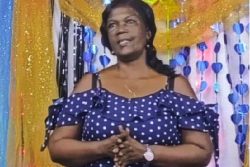Every culture has music; in many instances more than one genre exists and in some cases there are fusions. The statement that music is universal, while cliched, is nevertheless true. People communicate through music, which can uplift and motivate, or dash down and sadden. It depends on the music.
Banchikilli music, which is part of the culture of the Arawak community, does the former even as listening to it during this month provokes a sense of nostalgia.
Banchikilli is an Arawak word that means “to dance to the violin and banjo.” According to what is known of its history, Banchikilli emerged in Santa Rosa during the early nineteenth century. As a musical expression among the people of Santa Rosa who dwell in settlements along the Moruca River, Banchikilli takes its cues from a fusion of indigenous melodies and southwestern European rhythms.
Santa Rosa is a large community with many small villages, making it the largest indigenous-populated area in the region and in Guyana. Located in the North West District, Region One (Barima-Waini), the area is home to Lokono (Arawak) and other indigenous peoples such as the Carib and Warao.
In his MA Thesis titled ‘Ethnic Conver-sations in Sonic Spaces’, ethnomusicologist Rohan Sagar quoted musician and culture-bearer Basil Rodrigues, who contended that Banchikilli music was introduced to Guyana by a group of Arawaks who fled Venezuela in 1817 to escape the Bolivarian revolutionaries. They brought with them their cultures and traditions, including their music, to the then British Guiana – their new homeland. The Spanish Arawaks had by then harmonised the Lokono Mari Mari melodies and Joropo rhythms, resulting in a distinct folk sound known as Banchikilli.
Rodrigues, who died in 2014, besides his devotion to sustaining the Arawak language and culture, was a huge proponent of Banchikilli music—so much so that along with other musicians, he had formed the Mariaba String Band, which was known for playing Banchikilli music. Rodrigues composed several songs in this genre and they became popular staples during Amerindian Heritage Month. It is not known whether studio recordings were done.
One of the earliest documented compositions in the Banchikilli repertoire reflected the Arawaks’ feelings of loss towards the place they had once called home. The song, “Rosita Colorou” or “Red Rose”, is both patriotic and sentimental. The name was believed to have been derived from a red rose that grew abundantly in the Angostura (now Ciudad Bolívar) region, from which the Spanish Arawaks had fled. Rodrigues situated this experience as one that awakened nostalgia among the Spanish Arawaks. The English lyrics, “I am not from here; I am from the other side; Where red roses grow”, implies that the Spanish Arawaks preserved the memory of the other side (Venezuela) though they could not return.
The Banchikilli sound can be described as a ‘glocalized’ musical style. Under-standably so, given that it is the only music genre in the Santa Rosa area that incorporates both global and local musical elements. The thumping sound of the Sambura drum forms the core beat or element of the music, which is influenced by the Joropo rhythm and tempo and is typically upbeat and moderately fast. The flow of the Mari Mari melodies is layered on this rhythmic structure. Lokono Mari Mari music encapsulates all aspects of life in sound.
Mari Mari can range from songs relating to healing, love, lullabies to a dance form. It even transcends into work songs. The famous song “Matapee Mission”, which is played throughout Amerindian Heritage Month, is one notable example. The song is sung while cassava is being processed through the matapee, a cylindrical-shaped object into which the grated root is placed and pressure is applied at the bottom to release the fluids.
Banchikilli is recorded and performed exclusively by the descendants of Spanish Arawaks in Santa Rosa. As per tradition, it is common for Banchikilli to be performed with a number of European instruments including the banjo, violin, ukulele and guitar. Indigenous instruments such as the flutes, maracas or shak shaks as well as the sambura, a box-shaped drum native to South America, are also used. Banchi-killi performances are usually presented in group settings and performed by groups of musicians, with the last recognised being the Mariaba band.
The performances are carried out alongside Christian holidays and holy days such as Christmas and Easter as well as during wakes, baptisms and weddings. Banchi-killi music is also featured in community-based social activities and events such as the kayap or self-help.








